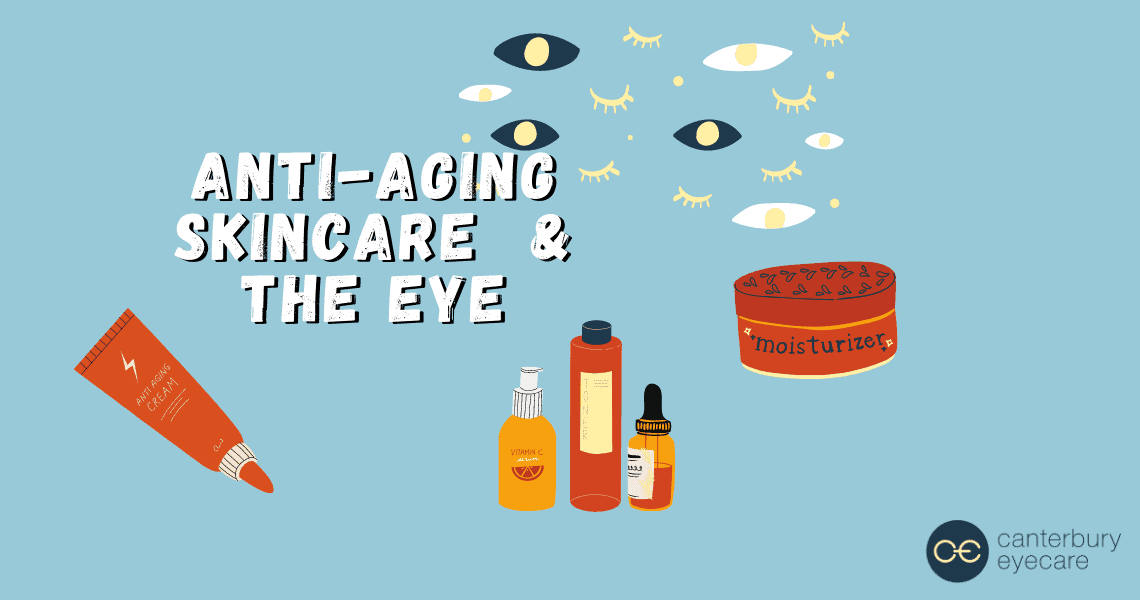Caring about your eyes extends to the skin around your eyes too. This month we have explored anti-aging skincare, make-up and cosmetic procedures around the eye.
Did you know eyelid skin is the thinnest in the human body and the first area on your face to show signs of UV damage and aging?
The skin around the eyes is the thinnest skin in the body and hence it is vulnerable to damage, with UV radiation and aging being significant factors. Genetics, hydration and fatigue can be other factors. Caution should be taken in choosing skincare products to use around the eyes, eyelids and periorbital skin. Any product, if used too close to the eyes, can seep into the eyes and disrupt the tear film which in turn causes irritation or dry eyes.
UV Radiation
Prevention of UV radiation damage is the most significant factor in anti-aging eyecare. Almost every structure of the eye can develop damage from UV radiation, from corneal sunburn to skin cancers around the eye, cataracts and macular degeneration.
UV exposure exponentially accelerates the photoaging process.
Pilkington et al.
Direct sun exposure has limited risk of melanomas inside the eye but these may develop secondary to systemic melanomas and can be sight, as well as life, threatening.
Protection from UV radiation includes using a physical blocking sunscreen, sun protective measures such as clothing, hats and eye protection as well as not smoking.
A broad-brimmed hat alone reduces UV radiation to the eyes by 50%.
Cancer Council Australia
Optical appliances that protect from UV damage include large wrap around and close fitting sunglasses as well as contact lenses with UV blockers. Contact lenses with UV blockers minimise transmittance of UVA to inside the eye by around 90% but should be used in conjunction with sunglasses to also protect the whites of the eyes and the skin around the eyes. Additionally, all clear glasses have UV blocking filters but may not cover the skin around the eyes as well as larger sunglasses do.
Not all sunglasses are the same, retail stores are allowed to sell “fashion spectacles” which look like sunglasses but have no UV protection. Look for quality sunglasses from Optometry practices with the label “Category 2 or 3” rating sun protection. All sunglasses with any level of UV protection must block 95% of UV and the darkness of the lens does not mean it blocks more UV.
Aside from minimising the cancer risk and DNA damage from UV radiation, sunscreen also is protective against sun pigmentation and premature aging. For optimal protection from UV radiation sunscreens should have a SPF of at least 30, be broad spectrum which protects from UVA and UVB radiations and be water-resistant. Be sure to apply an appropriate amount and re-apply regularly. Some physical sunscreens that are formulated to be safe around the eyes and non-stinging to the eyes such as:
- Ultra Violette Lean Screen SPF 50+
- La Roche Posay Anthelios XL Anti-shine Dry Touch Facial Sunscreen SPF50+
Anti-aging Skincare
When it comes to treatment of already UV damaged skin, there is a wide range of skincare options available. Most skincare has active ingredients that come under the following categories: Antioxidants, Peptides, Growth Acids, Ceramides and Retinoids.
- Vitamin C formulations have great research to show they can cause significant improvements in damage from UV radiation such as fine wrinkles, skin laxity and hyperpigmentation.
- Vitamin E, especially if used in conjunction with Vitamin C, has also been shown to improve periorbital wrinkling and UV damage.
- Niacinamide is also well documented in its ability to reduce pigmentation, improve the skin’s barrier and reduce fine lines and wrinkles.
- Peptides and Growth factors in certain formulations have also clinically been shown to improve the appearance of periorbital wrinkles, however these are still evolving technologies.
- Alpha Hydroxy Acids (AHAs) are exfoliants that improve the synthesis of collagen and elastic fibres in the skin. They’re particularly useful in treating pigmentation.
- Hyaluronic Acid (HA) is present in significant amounts in the body and has been shown to maintain tissues elasticity and hydration. However, HA is only effective at very small molecule sizes.
- Ceramides improve the skin barrier function and hydration, which is essential alongside other anti-aging regimens.
- Caffeine may improve lower eyelid sagging and puffiness but also slows collagen development so may be cautioned in use for anti-aging.
- Retinoids, or Vitamin A, are anti-aging powerhouse ingredients but in certain formulations can be damaging to the Meibomian glands around the eyes which can cause chronic dry eye disease. Minimise use of retinoids directly around the eye area, however if indicated, formulations with retinaldehyde are most effective with the least potential for irritation.
- Green tea extracts are promising in anti-aging skincare but clinical application is difficult.
- Chamomile has limited effectiveness in treating puffiness of the periorbital skin.


